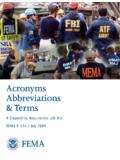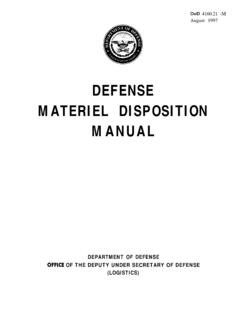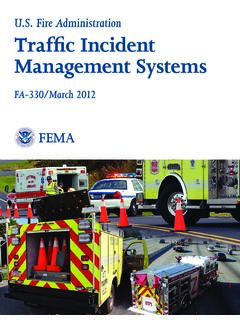Transcription of CMS Pandemic Plan v. 3.1 Public Release
1 CMS Pandemic plan v. Public Release Effective Date: 01/11/2021 DEPARTMENT OF HEALTH AND HUMAN SERVICES CENTERS FOR MEDICARE & MEDICAID SERVICES 1 This Page Intentionally Left CMS Pandemic plan Table of Contents Table of Contents Table of Contents .. 2 1. Introduction, Purpose, and Objectives .. 5 Introduction .. 5 Scope .. 5 Purpose .. 5 5 2 Context and 7 3 Concept of Operations (CONOPs) .. 8 Situation Overview: CDC and CMS Pandemic Phases .. 9 National Incident Management System .. 11 Plans and Procedures .. 12 4 Policy Response .. 13 Areas of Policy Action .. 13 Issuance of Waivers and Flexibilities .. 14 Summary of Waivers and Flexibilities Available To CMS .. 14 Relevant Categories of Waivers and Flexibilities .. 18 Waiver and Flexibility Review, and the Approval Waiver and Flexibility Review and Approval Process.
2 22 Other Areas of Policy Action .. 26 Clinical Standards and Quality Initiatives .. 26 Caring For Vulnerable Populations .. 29 Provider, Program Integrity, Supplier, and Beneficiary Enrollment and Eligibility Policy .. 31 Program Integrity and Evaluation .. 32 Value-Based Payment Policies (Including Quality and Financial Measurement and Performance) .. 33 Accelerated and Advance Payment Programs .. 33 Supporting Policy Activities .. 34 (Section Intentionally Removed) .. 34 (Section Intentionally Removed) .. 34 Reconstitution Activities To Assess Approved Waivers and Flexibilities .. 34 5 Engagement of External Stakeholders .. 35 Scope of Stakeholder Engagement .. 35 Forums for Stakeholder Engagement .. 35 Rapid Response Correspondence Process .. 38 3 CMS Pandemic plan Table of Contents Inquiry Response and Help 39 Internal Tracking of Stakeholder Concerns.
3 40 External Scan of Stakeholder Reactions .. 41 6 Operational Response .. 42 Areas of Operational Response .. 42 7 Direction, Control, and Coordination .. 46 Response Governance Structure and Administration .. 46 Pandemic Response Team .. 47 8 Information Sharing and Scenario Planning .. 51 9 Offices and Centers Actions By Pandemic Phase .. 54 Readiness and Preparedness (Phase 1B) .. 54 Pre-Activation (Phase 1C) .. 56 Activation (Phase 2A) .. 60 Operations (Phases 2B 2C) .. 64 Reconstitution .. 66 10 plan Development and Maintenance .. 69 ANNEX A Acronyms and abbreviations .. 70 ANNEX B 72 ANNEX K Strategic Planning Framework for the Center for Medicaid and CHIP Services .. 74 ANNEX L Revision History .. 88 ANNEX M Approvals .. 90 4 CMS Pandemic plan Executive Summary The COVID-19 Pandemic has affected people and industries across the country, exacting a heavy toll on every American.
4 The lives lost and the impact of the economic toll have touched every aspect of American life. With that knowledge and the response experience gained in 2020, CMS improved its Pandemic plan to ensure the Agency is able to meet the needs of its stakeholders and as a result, now stands better prepared for any future Pandemic events. CMS Pandemic plan has not simply been updated; it has been completely redesigned and provides CMS with the guidance and decision-making framework needed to best meet the needs of its internal and external stakeholders. This plan also details the steps taken to protect those on the CMS workforce who worked tirelessly to fulfill the agency s mission in service to all Medicare and Medicaid beneficiaries and all Americans enrolled in individual or group market coverage. Readers should pay particularly close attention to Section 4: Policy Response, which details the utilization of available waivers and flexibilities, and comprehensively inventories the processes and activities that take place during a Pandemic response.
5 In addition, Section 6: Operational Response defines a response structure that brings the operational and policy components together, expediting decision-making and accomplishing the goals of the Agency s response. This revised CMS Pandemic plan reflects and accounts for the complex and tightly coupled systems in which CMS operations and policy decisions are made. Decisions, data, processes, partner engagements, and key actions were captured to reflect the nimbleness needed to successfully respond to the ongoing Pandemic and to ensure guidance is available for future Public health emergencies. This plan is more actionable and applicable to CMS s entire body of work. It is an organized compilation of operational plans and policy playbooks, and will guide CMS in its preparation, response, and recovery from current and future Pandemic threats. 5 CMS Pandemic plan 1 Introduction, Purpose, and Objectives 1.
6 Introduction, Purpose, and Objectives Introduction The past two decades have proven that novel (new) viral pathogens and subsequent disease, such as Severe Acute Respiratory Syndrome (SARS), Middle East Respiratory Syndrome (MERS), Zika, Influenza ( , H1N1), Coronavirus Disease 2019 (COVID-19), and even a re- emergence of Ebola virus disease, pose a significant threat to a human population which may not have been previously exposed to these pathogens. Pandemic place an immense stress on government agencies, and specifically, regulatory agencies, which must rapidly institute policy actions to contend with the threat while experiencing significant disruptions to the organization s operations. For the Department of Health and Human Services (HHS) and its Operational Divisions, this scenario presents a uniquely critical challenge given the HHS s mission of leading the nation in preparing, mitigating, responding to, and recovering from Public health and medical emergencies.
7 The Centers for Medicare & Medicaid Services (CMS) are uniquely situated in such a scenario, as CMS must operate at the peak of its capacity as a regulatory and policy-making organization while also sustaining mission essential functions. To succeed in this mission, CMS must thoroughly prepare to withstand the threat of a Pandemic from a novel virus. Scope This document is concerned with CMS actions to prepare for, respond to, and recover from a Pandemic event. Longer-term preparedness actions ( ,, amending Standard Operating Procedures (SOPs) in response to past Pandemic events) are not covered in this document. Purpose In conjunction with the CMS Continuity of Operations plan (COOP plan ), this Pandemic plan represents policies and actions that are specific to novel virus pandemics. The procedures outlined in this plan can also be extrapolated, where appropriate, for other highly contagious pathogens or biological events.
8 This plan : Serves as a tool and reference guide in communicating CMS Pandemic preparedness, Pandemic response, illness mitigation, and recovery strategy. Assists CMS leadership in decision-making before, during, and after a Pandemic . Ensures compliance with CMS, HHS, Federal Emergency Management Agency ( fema ), and Federal regulations, guidance, and directives. Adheres to Department of Homeland Security (DHS) and White House continuity planning mandates and directives. Objectives The objectives of this plan include: 6 CMS Pandemic plan 1 Introduction, Purpose, and Objectives Protect the health and safety of CMS personnel, vendors and visitors by providing guiding principles for illness mitigation and recovery during a Pandemic . Identify the roles and responsibilities of CMS in participating in a whole-of-government response. Capture important policy and operational decision-making criteria to facilitate rapid implementation of waivers and flexibilities.
9 Ensure that CMS can maintain its Mission-Essential Functions (MEFs) and Essential Supporting Activities (ESAs) in the face of significant and sustained disruptions to its operations and workforce. Ensure the continuity of CMS leadership. Communicate Pandemic preparedness before, during, and in the aftermath of a Pandemic to all stakeholders. Achieve timely and orderly recovery for CMS from a Pandemic , resuming all functions and services while maintaining readiness and preparing for potential additional waves of illness. Outline the steps the agency should take in the event of a Pandemic . 7 CMS Pandemic plan 2. Context and Assumptions 2 Context and Assumptions Pandemics are extremely unpredictable. Using basic assumptions provided by the World Health Organization (WHO), CMS could expect that a novel virus Pandemic could begin at any time of the year, in any place in the world, and could spread across the globe within several weeks or months.
10 Medicare, Medicaid, and Children s Health Insurance Programs (CHIP) beneficiaries, and enrollees in health coverage, such as through a Health Insurance Marketplace 1 may encounter significant interruptions and delays in medical care as in-person provider consultations are halted or significantly modified due to infectious disease risk. Individuals may also encounter significant interruptions and delays in eligibility and enrollment processes for these programs. CMS workforce may also experience absenteeism exceeding the actual clinical attack rate for the particular Pandemic . The Pandemic planning efforts are based upon several critical assumptions: CMS will receive Pandemic updates and follow directives from HHS, Office of the Assistant Secretary for Preparedness and Response (ASPR), Centers for Disease Control and Prevention (CDC), fema , Occupational Safety and Health Administration (OSHA), the General Services Administration (GSA), and the White House.

















